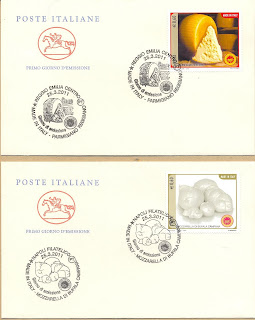
 This List of PDO Italian cheeses includes all the Italian cheeses which have Protected Designation of Origin (PDO) status under European Union regulations. These scrumptious FDCs were given to me by my dear friend Maria. Prior to 1996 when the PDO system came into operation, many Italian cheeses were regulated under a Denominazione di Origine (DO) system, which arose out of the 1951 Stresa Conference and was established under the Italian law 125/54. These appellations of origin were recognized in a number of European countries with which Italy had bilateral agreements. (The international framework of recognition was further developed—and extended from cheese to include other agricultural products—by the Lisbon Convention of 1958, and the modifications made to it at Stockholm in 1967, and by the TRIPS accord of 1994.) All of the existing “DO” cheeses were registered by the EU as “PDO” cheeses during the course of 1996. The four different types of cheese shown on the stamps atop the covers are :-
This List of PDO Italian cheeses includes all the Italian cheeses which have Protected Designation of Origin (PDO) status under European Union regulations. These scrumptious FDCs were given to me by my dear friend Maria. Prior to 1996 when the PDO system came into operation, many Italian cheeses were regulated under a Denominazione di Origine (DO) system, which arose out of the 1951 Stresa Conference and was established under the Italian law 125/54. These appellations of origin were recognized in a number of European countries with which Italy had bilateral agreements. (The international framework of recognition was further developed—and extended from cheese to include other agricultural products—by the Lisbon Convention of 1958, and the modifications made to it at Stockholm in 1967, and by the TRIPS accord of 1994.) All of the existing “DO” cheeses were registered by the EU as “PDO” cheeses during the course of 1996. The four different types of cheese shown on the stamps atop the covers are :- Gorgonzola (right top) is a veined Italian blue cheese, made from unskimmed cow's and/or goat's milk. It can be buttery or firm, crumbly and quite salty, with a "bite" from its blue veining.
Parmigiano-Reggiano (left top) is a hard granular cheese, cooked but not pressed, named after the producing areas near Parma, Reggio Emilia, Modena and Bologna (all in Emilia-Romagna), and Mantova (in Lombardia), Italy. Under Italian law only cheese produced in these provinces may be labelled "Parmigiano-Reggiano", while European law classifies the name as a protected designation of origin. It is informally known as the "king of cheese."
Buffalo mozzarella (left lower) (Italian: mozzarella di bufala) is a mozzarella made from the milk of the domestic water buffalo.
Ragusano (right lower). One of the most favorite Italian cheeses produced in Sicily. The cheese usually has a shape of a brick and it is made from unpasteurized cow's milk. The curd is heated and stretched until it is rubbery. Then it is pressed into rectangular moulds and the cheese is left to dry. Salted and rubbed, the cheese is ready for affinage that takes six months. During this period of time it is regularly rubbed with a mixture of oil and vinegar. After this period of time the cheese hardens and the taste becomes stronger and more savory.
No comments:
Post a Comment